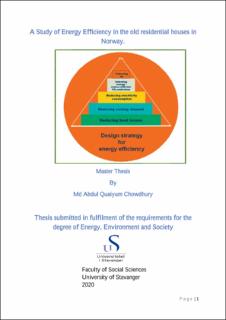| dc.contributor.advisor | Langhelle, Oluf | |
| dc.contributor.author | Chowdhury, Abdul | |
| dc.date.accessioned | 2021-02-16T12:39:26Z | |
| dc.date.available | 2021-02-16T12:39:26Z | |
| dc.date.issued | 2020-08-31 | |
| dc.identifier.uri | https://hdl.handle.net/11250/2728395 | |
| dc.description | Master's thesis in Energy, Environment and Society | en_US |
| dc.description.abstract | The rapid and predicted warming of global average temperature to 1.50 C presents a challenge for the capability of the current and impending generations to ensure their necessities. This is extensively owing to industrialization that has impacted an environmental footprint globally. The ecological imbalances are fuelled by the synergies of high energy intensity, high energy consumption in all sectors (such as industry, transport, and buildings) of humans’ daily life, and upward econometrics gross domestic product (GDP). Among all the energy-intensive sectors, the building is one of the biggest-consumed sectors of energy globally. Most of the stakeholders around the world are in the fight to reduce the emissions from the commercial, public, and residential buildings. Concurrently the Norwegian government has been implemented numerous policies to scale EE(energy efficiency) up in the residential buildings along with scaling the emission down to build the emission-neutral society by 2050, although the improvement level of EE in the residential buildings is not satisfactory. Therefore, the aim and purpose of this thesis are to identify the key barriers and presents possible solutions to improve the EE level in the old residential buildings in Norway. The thesis abductively analyses the barriers of EE through a qualitative thematic analysis of the key barriers and possible solutions. The overall objective of the thesis is to map the EE gap in the old residential buildings in Norway, which leads to creating the hindrances in the process of EE up-gradation in the existing building stock. The findings for the sluggish nature of EE up-gradation in the old building stock in Norway, are the insignificant financial assistance, lack of necessary information and cheap energy to be more important, and other common constraints as well.
| en_US |
| dc.language.iso | eng | en_US |
| dc.publisher | University of Stavanger, Norway | en_US |
| dc.relation.ispartofseries | Masteroppgave/UIS-SV-IMS/2020; | |
| dc.subject | klimaendringer | en_US |
| dc.subject | energiforbruk | en_US |
| dc.subject | co2 | en_US |
| dc.subject | global oppvarming | en_US |
| dc.title | A Study of Energy Efficiency in the old residential houses in Norway | en_US |
| dc.type | Master thesis | en_US |
| dc.rights.holder | Abdul Quaiyum Chowdhury | en_US |
| dc.subject.nsi | VDP::Teknologi: 500::Miljøteknologi: 610 | en_US |
| dc.subject.nsi | VDP::Samfunnsvitenskap: 200 | en_US |
| dc.source.pagenumber | 153 | en_US |
